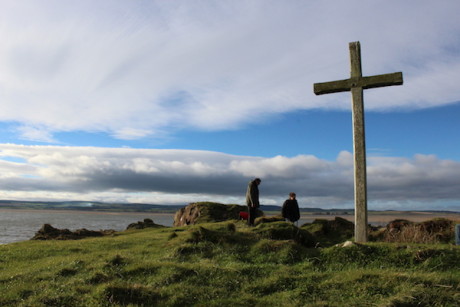
When you picture a monastery, what you see is probably medieval; all cloisters, gatehouses and soaring masonry. But they weren’t always like that, and Lindisfarne is the perfect example, explains Rose Broadley.
This little North Sea island is home to a world-famous monastery, but the ruins that stand today are Medieval; there was another Anglo-Saxon one built five hundred years before that.
Founded in AD635, this monastery stood at the heart of the great Anglo-Saxon kingdom of Northumbria. First sacked by the Vikings in AD793, its inhabitants eventually fled and didn’t rebuild it until AD1000-1100.
In the intervening years, religion and monasticism changed drastically, and so did the architecture that went with it. While medieval monasteries tend to be compact, stone-built and laid out according to a pretty standardised ground-plan, earlier Anglo-Saxon ones were more spread out, often built of wood (at least initially), and most certainly did not conform to any kind of rigid ground plan – its constituent buildings could be almost anywhere with the monastery bounds.
DigVentures is about to kick off a crowdfunded excavation to try and locate Lindisfarne’s original Anglo-Saxon monastery, and it will be a very different task to looking for a Medieval one. Here’s why.
1. They had no cloisters
Cloisters are the architectural manifestation of the theological concept of ‘enclaustration’ (withdrawing from the world to worship) and probably one of the first things you think of when you picture a monastery. And yet the earliest examples don’t appear until the end of the 8th century in Carolingian Francia at places like Lorsch, or until the 9th century in places like Inden in Germany and St Wandrille in Normandy. In England, they don’t seem to have arrived until the Saxo-Norman revival of monasticism in the late 10th and 11th centuries, although no one seems to know exactly where the first one was – if you have the answer to this, please do let us know!
2. They were closer to nature
Rather than having cloisters to shut them off from the world, the boundaries of Anglo-Saxon monasteries were more often defined by natural features in the landscape – islands, headlands and river bends were all popular, and they all brought the added benefit of access to the ‘whale roads’ of contemporary writing. Hilltops were also common, literally raising the monastery above the day-to-day world – as at recently excavated Lyminge, Kent, which was located on the end of a chalk spur overlooking a natural spring. The case of Lindisfarne is a classic, combining a coastal island location, and a headland on the island defining three sides of the site; finding the fourth boundary feature would be brilliant.
3. They had more space
Overall the early monastic settlements were more varied and dispersed in layout, and often spread out of much larger areas of land than later ones. Within, there would usually have been more open ground than one might expect, with buildings spaced some distance apart, and inner zones for worship, habitation and light industry divided by earthwork boundaries.
4. They had more wood and less stone
The majority of buildings at most monasteries were built using timber until after the Norman Conquest and it was often the church that was built in stone first, as at Lindisfarne and at Lyminge. However, hard evidence for the structures and layout of Saxon and Norman monasteries in England is still limited and all future clues will be important.
5. They argued about Celtic vs. Roman style
In the AD 600s, the big question facing the Church in England was whether to retain the native Celtic church or move towards Rome. At the synod of Whitby in AD 664, the pendulum swung decisively toward Rome. Monasteries like Lindisfarne, which had been established in the Celtic tradition, found themselves on the front line. From this point onwards, Roman and Benedictine ideas spread rapidly. St Benedict had laid down his regula (rule) for monastic life in sometime between AD 480-547. The structures and rhythm of the Rule undoubtedly influenced monastic architecture in the centuries to come, accommodating the communal prayer eight times daily with dormitory buildings directly connected to the church, for example.
6. They had different Monastic orders
It was still another few hundred years until we can see recognisable Benedictine rule being applied in England around the 10th and 11th centuries, or for the monastic orders familiar from the high Medieval period to arrive. By the end of the 13th century, as well as Benedictines there were Cluniacs, Carthusians, Cistercians, Augustinians, Premonstratensians, and Gilbertines in England – and that is not including the Orders of friars, the Dominicans (Blackfriars), Franciscans (Greyfriars) and Carmelites (Whitefriars). Monasticism in the high Medieval period was more regulated, and more complicated.
7. They had more women involved
Double monasteries of monks and nuns were much more common in the Anglo-Saxon period than later, as were Abbesses leading them. Hilda at Whitby is a famous example, as is Queen Ethelburga of Kent at Lyminge. Overall, women had a more equal and obvious presence than later. In the case of Lindisfarne, a number of female gravestones, including one for a woman called Osgyth, have been found. Who these women were and the nature of their place in the community is currently still a mystery.
8. And finally, there were a few things they had in common…
The key differences notwithstanding, many features of later Medieval monasteries were present in an earlier, simpler or smaller-scale form in Anglo-Saxon monasteries. For example, early stained glass windows appeared at some of the richest monasteries, such as Jarrow in Northumbria, although they were much smaller than later on, with no firm evidence for pictorial designs. Likewise, they had much in common with the habits worn by monks (tunics and scapulae of undyed wool) and Roman-style tonsured hair; the relative wealth and luxuries (wine, precious metal plate, silks, spices, pigments), the libraries and scriptoria, and the focus on hospitality and agriculture as well as worship.


